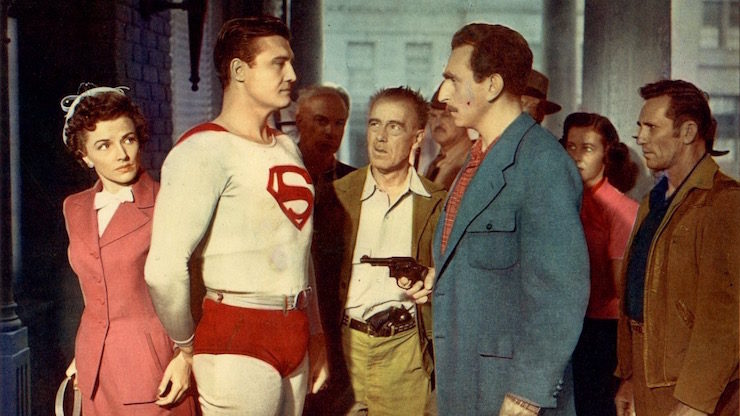In the late 1930s, National Periodical Publications had two magazines that would change history: Action Comics, the first issue of which featured “Superman,” a colorful, powerful character created by Jerry Siegel & Joe Shuster, and Detective Comics, the 27th issue of which featured “Bat Man,” a darker, nastier character created by Bill Finger & Bob Kane. They quickly became the two main templates for the modern superhero: the one a big, bold, brightly colored hero of the people with tremendous power, the other a darker, scarier defender of justice who used his brains, training, and wealth.
Both characters became huge hits, and they were quickly adapted into other media. Columbia Pictures licensed the rights to do movie serials, of which four were produced—two Superman ones starring Kirk Alyn as Clark Kent and his alter ego and Noel Neill as Lois Lane, and two Batman ones starring, respectively, Lewis Wilson and Robert Lowery as the caped crusader. In addition, Paramount did animated shorts featuring Superman, produced by Max and Dave Fleischer, and the radio station WOR produced a long-running radio series, both of which had the great Bud Collyer providing Superman’s voice.
Superman’s continued popularity after World War II and the burgeoning television market led to the development of a TV series, but the producers wanted to hedge their bets and test out the concept first. So they gave us a feature film in 1951. This may have been partly due to the feeling among many, including star George Reeves, that television was a passing fad, and the movie was made to make sure there’d be something lasting. (In hindsight, this is hilarious, but TV was still very new in 1951…) The Kellogg’s-sponsored The Adventures of Superman television series debuted the following fall, which lasted for six seasons. Reeves and Phyllis Coates starred in the film as Superman and Lois Lane, respectively, and they continued to the TV series, alongside Jack Larson, John Hamilton, and Robert Shayne. When Coates was unavailable after season 1, Neill was brought back to play Lane. (This movie was also re-cut into a two-part episode of the series.)
Batman didn’t make it back to the screen until the 1960s, when 20th Century Fox acquired the rights to do Batman and farmed it out to William Dozier, who wanted very much to do a feature film to lead in much as Superman had received a decade and a half earlier. Fox didn’t go for it, and the show was also rushed into production as a midseason replacement in January 1966. It proceeded to become such a huge hit that Dozier’s movie was greenlit, and aired between the first and second seasons. Adam West starred as Batman, with Burt Ward as Robin, along with Alan Napier, Neil Hamilton, Stafford Repp, and Madge Blake. All six were in the film, along with four of the show’s established recurring villains: Cesar Romero as the Joker, Frank Gorshin as the Riddler (for which he had received an Emmy nomination), Burgess Meredith as the Penguin, and Lee Meriwether (filling in for the unavailable Julie Newmar) as Catwoman.
Powers and abilities far beyond those of mortal men
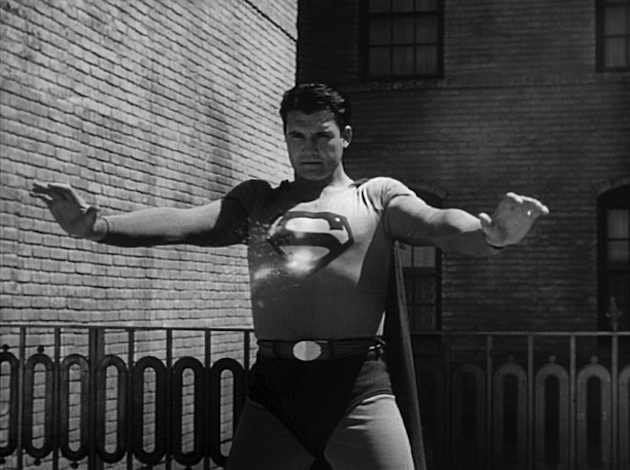
Superman and the Mole Men
Written by Richard Fielding
Directed by Lee Sholem
Produced by Barney A. Sarecky
Original release date: November 23, 1951
Superman and the Mole Men opens in the small town of Silsby, “Home of the world’s deepest oil well,” according to the sign at the town border. At an oil rig, the employees are throwing away a great deal of valuable and hardly used equipment. The answer to queries as to why this is happening from the boss, Corrigan, boil down to, “I said so, shut up.”
The oil rig’s PR guy, Craig, drives Clark Kent and Lois Lane to the oil well to do a feature, and he’s rather surprised when the watchman, “Pops” Shannon, informs him that the rig’s being shut down. Kent and Lane travelled 2500 miles from Metropolis for this story, and it doesn’t seem to be much of one. However, the reporters do learn that they dug 32,740 feet—that’s more than six miles down, and deeper than anyone’s ever dug before. Before they leave, Kent notices the barely used equipment in the hole.
Later that night, after they’ve checked into the hotel, Kent and Lane decide to drive out to the well to see if they can learn anything else—maybe from Pops.
At the well, two creatures crawl up out of one of the drill holes. They’re basically human, but very short, with oversized heads, hair on the back of their hands, but none on top of their huge heads. They’re dressed in all black clothes. They investigate the oil rig, and see Pops through a window, reading something.
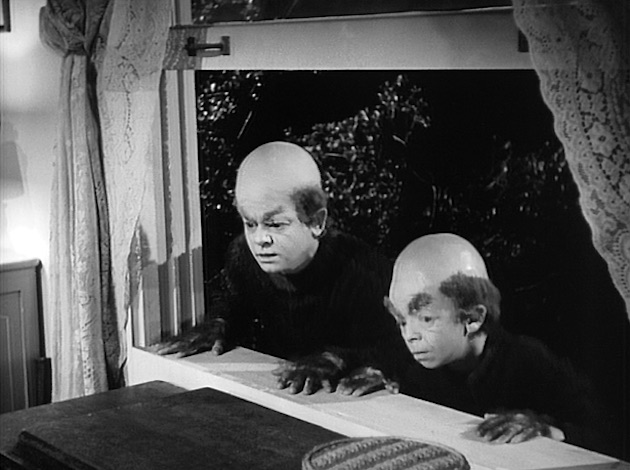
Kent and Lane arrive to find Pops dead. It might just have been a heart attack, but it might not have been. Lane calls Craig while Kent checks out the rest of the rig. While she’s on hold, Lane sees two of the creatures in the window and screams, but they’re gone by the time Kent responds. They get Craig, Corrigan, the sheriff, and the coroner to the rig. The coroner thinks it was a heart attack and nobody really believes that Lane saw what she saw. Everyone leaves except for Corrigan, who will wait for someone to fetch Pops’s body, and Kent offers to stay with him.
Once they’re alone, Kent tries once again to find out what was in Corrigan’s report that led to the rig being shut down. Corrigan shows Kent five test tubes with material taken from the drill—they all glow in the dark, with increasing brightness the further down the material came from. He thinks it might be radium (he’s sent for a Geiger counter). On top of that, once they reached a certain point, the drill broke through to nothing, as if the center of the Earth was hollow. Additionally, six miles down, there were one-celled organisms that were on the drill, which means something’s alive down there.
The two creatures are seen outside town, scaring the coroner’s assistant so much that he drives into a ditch. Kent and Corrigan turn the lights out to leave, and discover that the oranges that Pops was eating are now also phosphorescent. Meanwhile, the two creatures continue to explore, eventually arriving at a house, where they are greeted by a little girl, whose reaction is much calmer than Lane’s, saying hello and asking who they are.
Kent and Corrigan talk down a mob that has formed in the hotel, led by a man named Benson, that is going out to hunt the creatures down and shoot them. Kent points out that they are probably just as scared of surface-dwellers as they are of them. He urges them to go home and lock their doors and let him handle it.
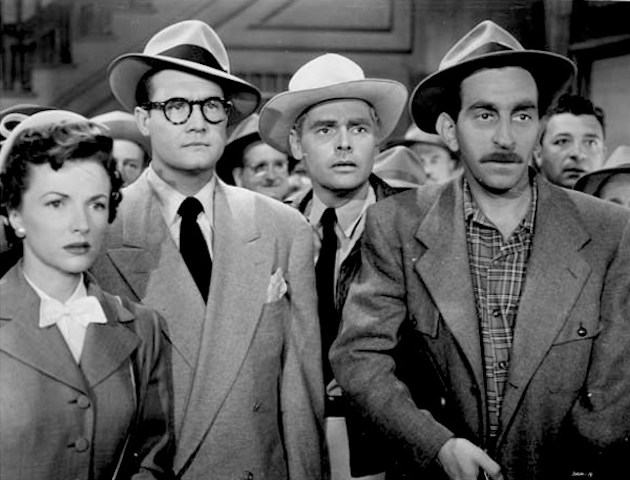
The girl plays ball with the creatures, who seem to be enjoying themselves (and also making the girl’s ball glow), but when the girl’s mother enters, she screams loud enough to be heard in the hotel. The mob all runs toward the screaming, while Kent runs into an alley (to Lane’s chagrin) and changes into Superman.
Flying over the town, he gets to the house ahead of the mob, warning them off by bending Benson’s rifle in half and standing there while Benson punches him and badly hurts his hand. Everyone disperses, and Lane, Corrigan, and Craig approach Superman, Lane really really glad to see him.
The mob’s hounds catch the scent of the creatures and track them to the dam. Superman follows by flying off, impressing the heck out of Corrigan and Craig (Lane just smiles). Superman tries to warn Benson not to shoot them, especially on the dam, as they’re radioactive. If they fall into the reservoir, they’ll contaminate the water supply. Benson is unimpressed and shoots Superman futilely, and Supes socks him in the jaw. Another guy shoots one of the creatures, and he falls—Superman flies off to catch him and takes him to a hospital, while the mob chases the second one to a shack. The creature hides in it, surrounded by the hounds. Benson leashes the pooches and puts dry sagebrush around the shack in order to burn the place down. (He does this right next to a barrel, and I’m thinking he should maybe have checked to see what was in the barrel first…)
As the fire rages, the creature yanks up a floorboard to get under the shack and crawl out to safety. He runs for the oil rig and climbs back down the hole to the center of the Earth where it’s safe.
Benson gleefully reports to the sheriff that they took care of both creatures, but upon learning that one is at the hospital, he sends his boys off to string the creature up. When the sheriff tries to stop them, Benson pulls a gun on him and later punches him and has the sheriff put in jail by the mob.

At the hospital, Kent assists the doctor in removing the bullet from the creature (the nurse refuses to get anywhere near the patient). Lane arrives and castigates Kent for not being around. Why he doesn’t mention that he assisted the doctor is left as an exercise for the viewer. Craig and Corrigan show up ahead of the mob saying that they’re out for blood. Kent says he’ll be right back, and Lane accuses him of cowardice in absentia. Benson’s people punch out Corrigan and grab Lane.
Superman then steps through the door and makes it clear he won’t let anyone in—though he does allow Craig to bring the injured Corrigan in for treatment. Lane frees herself from her captors with some well placed elbows and then is almost shot, but for Superman’s quick reaction. Supes sends Lane inside and then takes everyone’s guns away, tossing the people themselves aside like cordwood.
The next morning at the oil rig, the creature comes back with a couple of friends and a weapon. They sneak into the town and see a bunch of people heading into the hotel. One of Benson’s cronies sees them.
The creatures arrive at the hospital, and they encounter Superman. He tries to talk to them. The second creature remembers him as the one who saved their friend. Supes goes inside to retrieve the wounded creature in the hopes that it will end this whole thing peacefully.
Unfortunately, Benson goes alone with a rifle to the hospital. The creatures turn their weapon on Benson, which causes him great pain, but Superman then arrives and stands in front of the beam. Benson tries to thank Superman for saving his life, but Supes won’t even look at him when he replies, “That’s more than you deserve,” and goes off with the creatures.
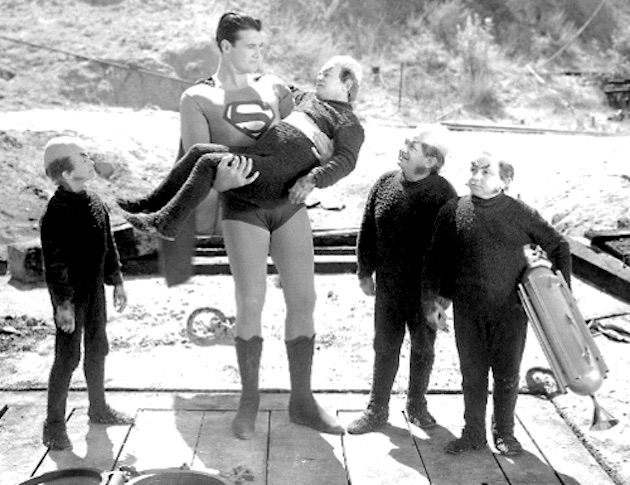
With Supes carrying the wounded one, they return to the oil rig and head back down the hole.
Lane, Craig, and Corrigan arrive at the rig, where Corrigan reveals that the creatures aren’t radioactive—it’s just phosphorescence. (It’s probably how they can see so far underground.) And then the rig explodes, the creatures having destroyed it to keep the two worlds separate.
To the batpoles!
Batman
Written by Lorenzo Semple Jr.
Directed by Leslie H. Martinson
Produced by William Dozier
Original release date: July 30, 1966
What follows is an abbreviated version of the plot summary of Batman (1966) from “Holy Rewatch Batman!” on this site, originally published on 19 February 2016.
A yacht carrying a dehydrator invented by Commodore Schmidlapp is en route to Gotham City. Bruce Wayne and Dick Grayson have received word that the commodore is in danger, so they slide down the Batpoles to change into Batman and Robin and take the Batcopter out to sea—but then the yacht disappears, after which point the Dynamic Duo are attacked by an exploding shark that they barely escape with their lives from.
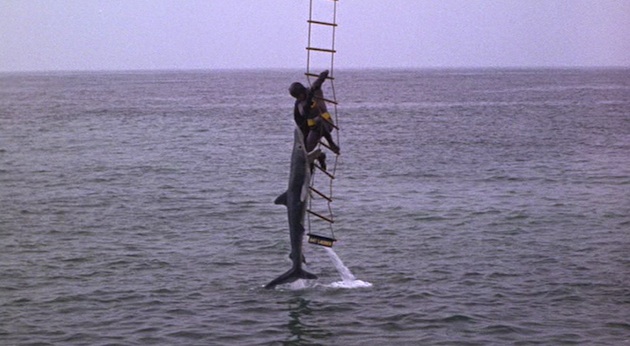
Later, Batman gives a press conference in Police Commissioner Gordon’s office. He denies that a transatlantic yacht just disappeared, and refuses to answer any further questions about the yacht or the exploding shark (which he says was probably some unfortunate animal who accidentally swallowed a mine).
Kitanya Irenya Tatanya Karenska “Kitka” Alisoff of the Moscow Bugle asks if Batman can take off his mask so she can get a better picture. He explains that his effectiveness as a crimefighter requires that his true identity remain a secret.
After the press is dismissed, Gordon, Batman, Robin, and Chief O’Hara realize that this could be a team effort by four of Batman’s rogues’ gallery, all of whom are not presently incarcerated: the Penguin, the Joker, the Riddler, and Catwoman.
Our Soviet journalist turns out to be Catwoman in disguise, and she has indeed teamed up with Joker, Riddler, and Penguin to form the United Underworld (their slogan: “today Gotham City, tomorrow the world!”). They squabble amongst themselves (Riddler is peeved that Penguin’s exploding shark trick failed), but quickly calm down, as they need to put aside their egos for the greater, er, bad. Penguin even quotes Benjamin Franklin (“we must hang together or most assuredly we will hang separately”).
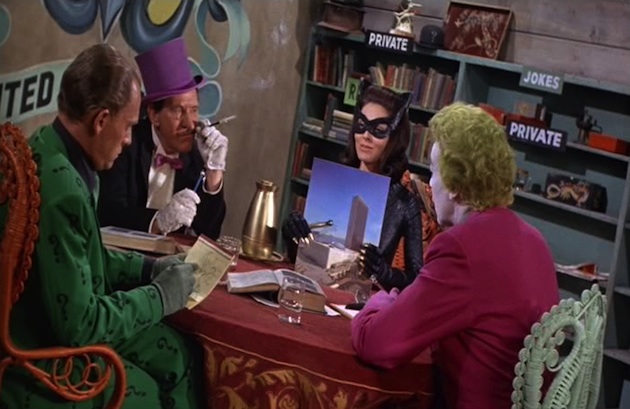
The United Underworld have kidnapped Schmidlapp, and placed him in a replica of his cabin on the yacht, explaining that they are fog-bound in the Outer Banks.
Our heroes get into the Batboat and investigate an unauthorized bell buoy where the illusory yacht was. Right under the buoy is the United Underworld’s submarine. Batman and Robin find a shark cage attached to the buoy as well as lenses for the hologram of the yacht.
Penguin uses magnets to attach our heroes to the buoy and fires a torpedo. Batman tries to use the bat-transmitter to mess with the torpedo’s signal, and it explodes prematurely. The same happens to the second torpedo, but the batteries in the bat-transmitter die before he can mess with it. It explodes when it’s supposed to, and the bad guys squeal with glee.
However, our heroes survived! A porpoise hurled itself into the path of the final torpedo, allowing Batman and Robin to survive. (How they demagnetized themselves from the buoy is left as an exercise for the viewer.)
The Dynamic Duo calls the Pentagon, learning that the Navy recently sold a pre-atomic surplus submarine to a man named P.N. Gwynne, whose only address is a PO box. After Batman scolds the admiral, who belatedly realizes that selling a submarine to someone who doesn’t provide a proper address may not have been the hottest idea, a missile shoots through the air from the sub and skywrites two riddles in the form of jokes: “What does a turkey do when he flies upside down?” (gobbles up) and “What weighs six ounces, sits in a tree, and is very dangerous?” (a bird with a machine gun).
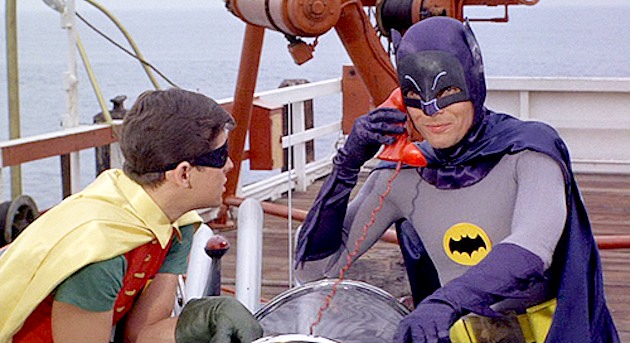
Back in the bad guys’ lair, the Riddler comes up with a plan that uses all their tricks. Catwoman—disguised as Kitka—will seduce and kidnap some millionaire (Riddler suggests Bruce Wayne, because of course he does), and Riddler will plant a clue that leads to the hideout. Batman will follow that clue to Joker’s jack-in-the-box, which will spring Batman out the window and onto an exploding octopus of Penguin’s. It can’t possibly fail!
Kitka pays a visit to Wayne Manor, claiming to have received some riddles on Wayne Foundation stationary. Bruce says it’s probably the work of some crank, and then invites Kitka to dinner, which she, of course accepts. Then he heads to the Batcave where he and Robin decipher the riddles: “What has yellow skin and writes?” A ballpoint banana. (Naturally.) “What people are always in a hurry?” Russians. (That’s actually almost clever.) They assume it’s a threat to Kitka’s life.
Bruce and Kitka go to dinner, violin players in the background. (Alfred and Robin keep an eye on them via the Batmobile’s surveillance tech.) They then take a horse-drawn carriage to a night club, and they dance to a French singer. Back in the horse-drawn carriage, Bruce flirts outrageously, to the point that Robin turns off the surveillance. Robin checks in with Gordon, and suggests activating the bat-signal. The bad guys will think that Batman and Robin are en route to police HQ, and they’ll view that as the best time to attack Kitka.
“Kitka” surreptitiously signals the other three while they flirt, and they head back to her borrowed penthouse apartment, where they smooch before Kitka changes into a sexy pink robe. Bruce quotes Edgar Allan Poe’s “To One in Paradise” at her.
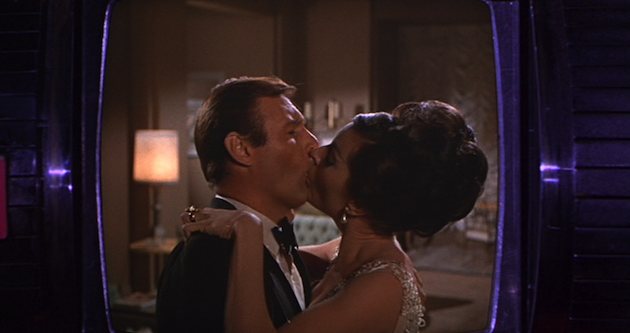
Joker, Riddler, Penguin, and their henchmen fly to the penthouse on flying umbrellas. Bruce says that he has a feeling he’s about to be madly carried away—and then the three bad guys and the henchmen show up to madly carry him away. Bruce puts up a good fight, but is subdued. Robin turns the surveillance back on—just to peek for a second—to see that the place is empty and the bad guys are flying off on brooms.
Bruce wakes up in the United Underworld HQ and immediately asks where Kitka is, threatening to kill them all if she’s harmed. Catwoman agrees to take him to her, and he’s blindfolded and led down a labyrinthine path that gives Catwoman time to change. Bruce tells “Kitka” that they’re screwed, but she says that she overheard that she and Bruce are bait for Batman. She’s sure they’ll be freed once Batman is trapped. Bruce is less sanguine (for reasons he can’t divulge). He also tells Kitka that he keeps a radio transmitter by his left elbow—a common security device employed by capitalists such as him who carry large sums of money.
The other three are listening in, of course, and grab Bruce and untie him to remove the transmitter. But there is no transmitter, it was a ruse to get himself untied, and fisticuffs ensue—one of the henchmen falls onto the jack-in-the-box and is sprung to the waiting tentacles of the exploding octopus.
Bruce manages to jump out the window and swim to safety, returning to Wayne Manor to a relieved Dick and Gordon. After getting rid of Gordon, they head down the poles to the Batmobile and speed off.
The U.U. grab Schmidlapp’s dehydrator and use it on five guinea pigs. All five strapping young men have all the moisture removed from their bodies, leaving only piles of blue dust. Catwoman and Penguin put the bits of dust into separate containers.
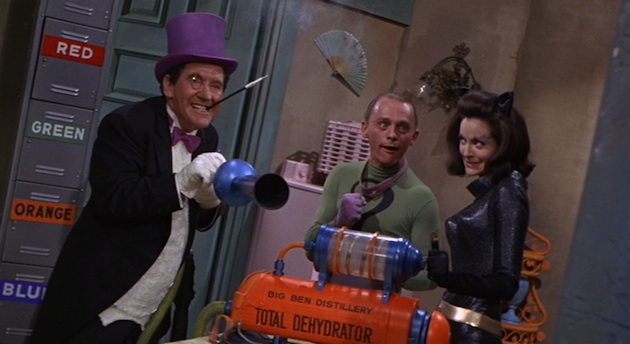
Batman and Robin arrive at the docks, intending to ambush the U.U., but they find only an empty hideout and a bomb. Batman briefly searches for Kitka, but finds nothing, so he grabs the bomb and heads down to the bar. But not all the patrons evacuate (two women refuse to end their meal), so Batman runs around the docks trying to find an uninhabited place to toss the thing, and failing rather miserably, until he finds an empty spot of water to toss it into.
Penguin shows up disguised as Schmidlapp, a disguise the Dynamic Duo see completely through. But he insists he’s Schmidlapp—and he also has plastic coated fingers after scorching his fingertips, so they can’t check his fingerprints. However, there’s a retinal scanner in the Batcave, and they gas him and bring him there. Penguin asks for water, and after going to the drinking water dispenser, he hooks it up to the specimen bottles containing the guinea pigs, which were in his waistcoat. (However, he accidentally switched the lever to heavy water rather than light water; why a drinking water dispenser would ever dispense heavy water is left as an exercise for the viewer.)
The five guinea pigs are rehydrated, but because Penguin used heavy water, they are unstable and are turned to antimatter upon impact. Batman pretends to apologize to “Schmidlapp,” who obviously was kidnapped and brainwashed. They gas him and take him out, then wake him up and let him pretend to gas them and steal the Batmobile. They take the Batcycle to the airport, letting Penguin lead them to the U.U.’s new hideout by tracking the Batmobile from the Batcopter.
Unable to help himself, Riddler fires another riddle missile, but he lucks out and actually hits the Batcopter with the missile. Riddler is stunned—but not nearly as stunned as Robin to have them crash softly. Luckily, they landed atop a foam rubber wholesalers convention, specifically on an exhibit of foam rubber in its crude form (clearly labelled with a sign reading “FOAM RUBBER IN ITS CRUDE FORM”).
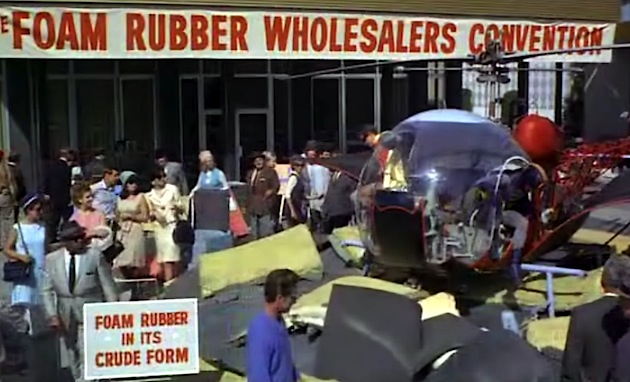
Then the missile explodes, providing two more riddles: “What goes up white and comes down yellow and white?” An egg. “How do you divide seventeen apples among sixteen people?” Make applesauce. Somehow they contrive this to mean the United World Building, which is having a session of the security council.
Batman and Robin run to the Gotham East River where the UW Building is located, the sub also arriving there with the dehydrator.
The nine members of the UW security council are arguing, each in their native language, and the U.U. dehydrate all of them in turn. They put each bit of delegate dust into a separate vial.
Batman and Robin order the building evacuated and head upstairs just as the U.U. are heading out with their dehydrated kidnap victims. However, Batman hesitates when Catwoman says that Kitka will die if they attack.
The bad guys go down to their sub, while Batman and Robin discover what they’ve done to the council. They head out to sea toward Short Island Sound, through which the sub will go out into international waters. The Dynamic Duo follows in the Batboat.
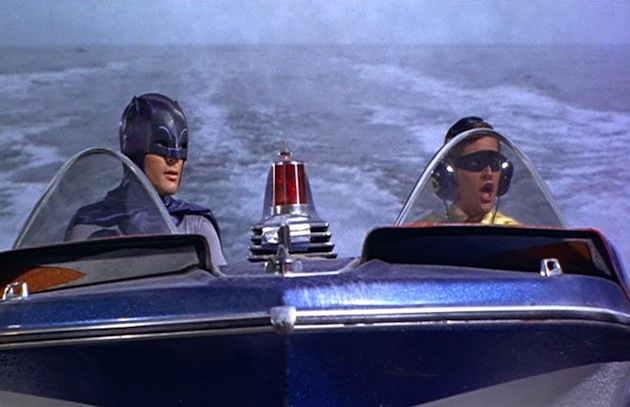
Riddler sends a ransom note to all nine countries, asking for a billion dollars from each nation for the safe return (and rehydration) of their delegate.
The U.U. fire a missile at the Batboat, but Batman has Robin jam it with the bat-radio. Then they try a torpedo, but the bat charge launcher detonates them prematurely. Penguin has them dive, but then Batman circles the sub with the Batboat while Robin fires the bat charge launcher at the sub. It rattles the sub enough that they are forced to surface. The Dynamic Duo board the sub, and fisticuffs ensue on the deck of the sub, until everyone except for Catwoman is knocked into the water.
Batman and Robin chase Catwoman into the sub, but she trips and her mask comes off and the Dynamic Duo realize that Catwoman and Kitka are one and the same. They manage to save the vials of dusty delegates—at least until Schmidlapp come out, stumbles into Batman, shattering the vials—then he sneezes, scattering the dust motes further.
Returning to the Batcave, the Dynamic Duo struggle to separate the dust particles into the right order. Once the work is done, they return to the UW building and rehydrate all nine piles of dust. Unfortunately, something went wrong, and the delegates are all speaking something other than their native tongues. They obviously got all mixed up.
Batman, though, is philosophical about it. Maybe this mixing of minds is the greatest service they could perform for humanity. He urges them to leave inconspicuously—through the window.
A doofy kind of heroism
It’s fascinating to watch these first two attempts at long-form live-action superhero movies back to back. Both were tie-ins to TV shows, the first as a sort-of pilot, the second as a reward for a job well done. Both show the main characters in the best possible light, as they do everything they can to preserve life, even to extremes. Superman stands in front of a weapon he knows nothing about in order to save the life of an asshole he’s been railing against for the whole movie. Batman goes to great lengths to dispose of a bomb without harming anyone. For all that “Some days you just can’t get rid of a bomb” has justifiably become a pop-culture punchline, the message of that scene is still an important one: life is sacred and should be preserved. Heroes are the people who work hard to preserve lives.
Even if those lives are weird little creatures with outsized heads and funny eyebrows, whose appearance is sufficiently scary that one old man dies of a heart attack at the very sight of them.
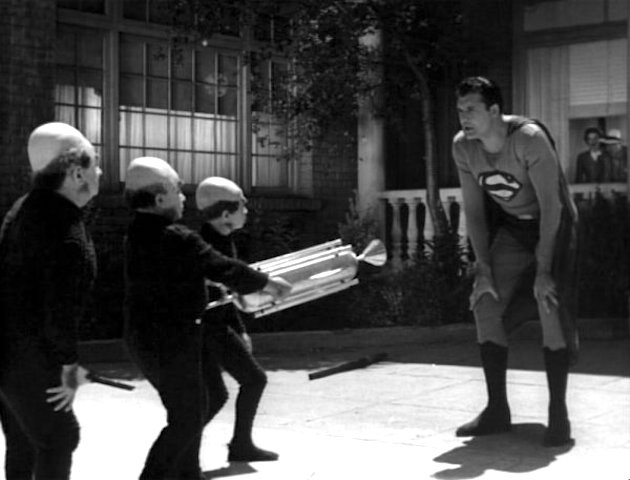
From the very beginning, Superman is trying to make sure that people survive and don’t do stupid stuff to get each other killed. Superman and the Mole Men comes across as the love child of the 1931 Frankenstein with Superman, down to the little kid who is the only one (besides our hero) who responds to the creatures with compassion. (The scene where they play ball is adorable.) Plus you have the science-goes-a-step-too-far motif with the oil rig that digs deeper than anyone has before, and the mob mentality taking over the adults.
Batman’s concerns are similarly noble, as he acts to keep people safe, whether the United World delegates, the ducks outside the U.U. headquarters, or “Miss Kitka.”
What’s most fascinating, though, is that these two movies are the reverse of what you’d expect, given the general histories of the two characters. When we think of Superman we think of a powerful being who can juggle tanks and whom bullets bounce off of. Superman’s enemies are guys who want to conquer the world or cause mass destruction. Batman, meanwhile, has often been the “dark knight detective,” but even in his goofier 1950s days (the comics that Dozier was riffing on for the TV series and this movie), his stories were generally a bit more street-level, dealing with colorful threats to Gotham City. Batman was always far less likely to save the entire world than Superman.
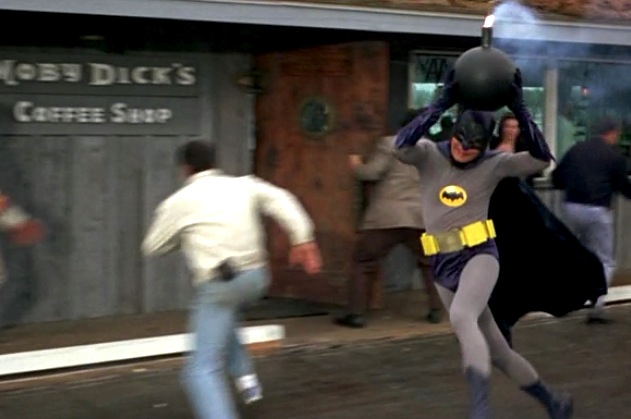
Yet in these two movies, those assumed positions are reversed. It’s Batman who is dealing with the fate of the world as the United World delegates are dehydrated and turned into dust, with world leaders hanging on his every move at the very end. It’s Superman whose case is remarkably microcosmic in scale. It’s just a small town at stake (a very small town), and while lip service is given to the macrocosmic issues beyond the confines of Silsby, they never get that far.
Superman and the Mole Men definitely has more heart. The creatures from beneath the Earth are tragic figures in the mode of Frankenstein’s monster—misunderstood due to being ugly by human standards. The goofiness of their appearance is due to the limitations of budget and technology in a 1951 feature film, and it’s to the script’s credit that it doesn’t succumb to that same cheapness. The creatures start out as monsters—even leaving a corpse in their wake—but Superman refuses to condemn them outright the way Benson does. And because Superman gives them the benefit of the doubt, so do we.
By contrast, Batman goes for the broader storyline, with exploding sharks, fancy gadgets, outlandish characters in ridiculous outfits, and silly performances. The creatures from six miles below look absurd by necessity—Joker’s supposed to look like that. (Well, maybe you’re not supposed to see his mustache under the white powder, but what can you do?) There is some social commentary here, but it’s more humorous satire. The end where the delegates get their brains swapped is a delightful jab at politics, not to mention the earlier commentary on military bureaucracy when the Navy belatedly realizes that selling to someone with an obvious pseudonym and no street address may have been unwise.
The Superman film has far more pointed commentary about the mob mentality, particularly at the end when Benson tries to thank Superman for saving his life, and the man from Krypton won’t even look at him. It’s a beautiful moment, giving a nasty person his comeuppance in a way that might actually do some good and make him a better person in future.
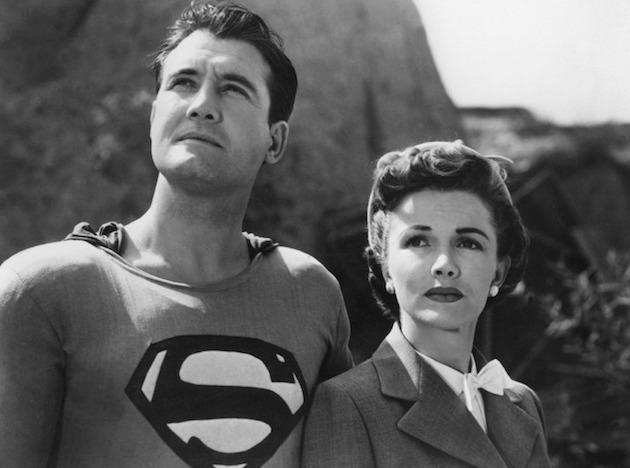
If only it had the acting to live up to it. Reeves does a lovely job playing the square-jawed, fair-minded hero who gets stuff done. The problem is—that’s how he plays Kent. And also Superman. The notion of a pair of glasses serving as a disguise was never a hundred percent convincing in the first place, and Reeves does nothing to distinguish one identity from the other. Kent is insistent on leniency for the creatures and to learn more about them, and Superman picks right up where Kent left off. Kent’s not being around when Superman is stands out even more in a tiny town of 1400 people. There’s just not enough differentiation here, and it makes the disguise utterly unconvincing. (It’s a frustrating contrast to Collyer who, in the animated shorts and radio show, did such a superlative job of deepening his voice for Superman as opposed to Kent. Not to mention what Christopher Reeve managed twenty-five years later.)
Coates’s Lane doesn’t really get to do much. She has the drive you’d expect from Lane, and she bitches about Kent’s cowardice, which isn’t very convincing given the way Kent stands up to people and assists with the surgery on the creature. But the main problem is that it’s absurd that the Daily Planet sent both of them on this story. A really really deep oil well is newsworthy, yes, but not so much that you send two ace reporters to cover it. She’s there because a Superman story can’t be done without Lois Lane, but she serves no real story function.
In his film, Adam West does a far superior job of differentiating Batman from Bruce Wayne, and by contrast, Wayne gets a lot more to do than is usual. On the TV series, ninety percent of the time, Wayne’s sole purpose was to answer the bat-phone in the early part of the episode and slide down a pole. He spent most of his time in costume. But the movie gives the Wayne aspect room to breathe, and West plays him differently, though much of that is due to his infatuation with “Kitka.”
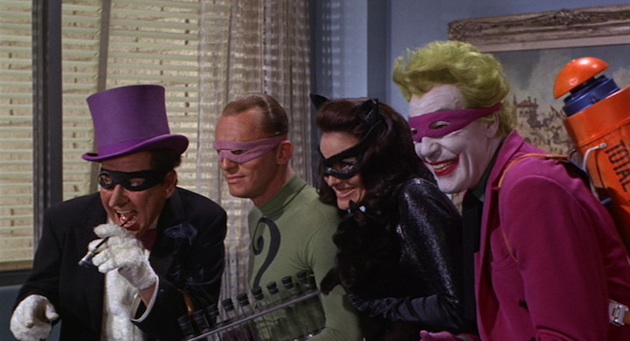
Batman also gives us much stronger villains, as any one of Romero, Gorshin, Meredith, or Meriwether would be worth the price of admission, and the best scenes in the movie are watching the four of them play off each other. By contrast, Benson, played by veteran character actor Jeff Corey, is played with all the subtlety that Corey would later bring to his role as Plasus in Star Trek‘s “The Cloud Minders,” to wit, none whatsoever. He’s a straw antagonist. We’re given no reason why he’s such an ass, he just is because the plot needs someone to lead the mob. To be fair, we’re not given any rationale behind any of the Bat-antagonists’ mendacity, either, but they’re also very OTT-nutsy-cuckoo that it’s much easier to roll with it. Benson is just a normal person, which makes his evil a bit closer to the bone, but also given nothing like context.
In truth, both these films are better known because of their links to popular TV shows than they are as movies on their own. The Adventures of Superman lasted six seasons and proved to be hugely popular. Reeves became inextricably linked with the role, sometimes to good effect—Reeves quit smoking because he didn’t want to be seen to be encouraging kids to take up the habit—and sometimes not so much—he had trouble finding non-Superman roles after the show ended. Batman only lasted half as long, but while it was shorter-lived, it was arguably just as popular, particularly in its first season, which was one of the biggest hits in TV history, and which has continued to influence the pop-culture landscape five decades later. West was similarly typecast, though he found himself embracing that in the 2000s all the way up to his death this year (including his final role parodying himself on Powerless). Reeves didn’t live long enough to come to such a catharsis, as he died of a possibly self-inflicted gunshot wound in 1959.
It wouldn’t be until the 1970s that the notion of the superhero film would divorce itself from television, and it would also be the next time that we would see Superman on the big screen. Next week, we tackle the four Christopher Reeve films—Superman, Superman II, Superman III, and Superman IV: The Quest for Peace.
Keith R.A. DeCandido‘s latest work includes the novel Marvel’s Warriors Three: Godhood’s End, the third book in the “Tales of Asgard” trilogy, and short stories in the anthologies Aliens: Bug Hunt, Baker Street Irregulars, The Best of Bad-Ass Faeries, Nights of the Living Dead, and TV Gods: Summer Programming. Available for preorder is his Orphan Black book Classified Clone Report. You can read his blog or follow him on Facebook, Twitter, or Instagram.










